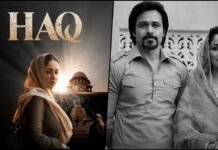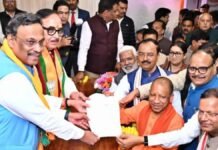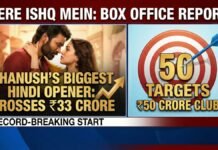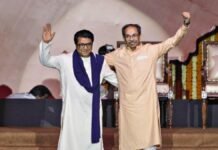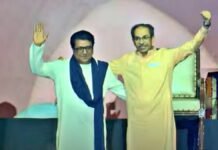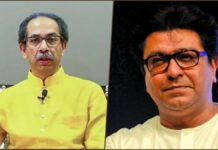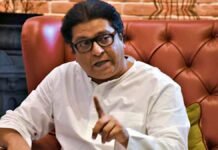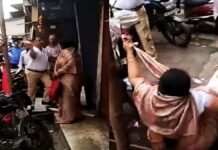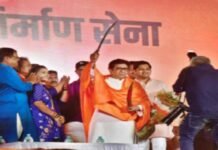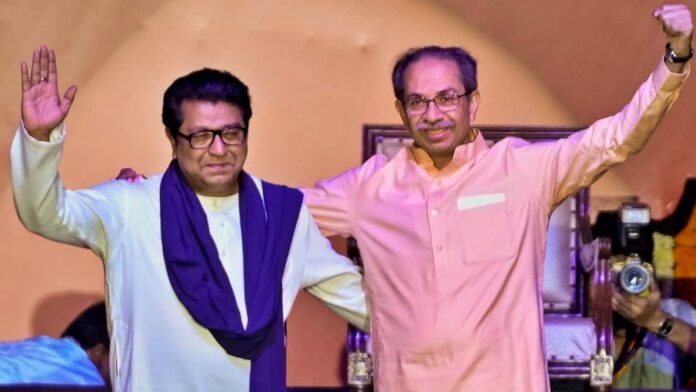
Key Points:
- Uddhav Thackeray meets cousin Raj at Shivtirth for 2.5 hours; alliance discussions intensify ahead of BMC elections
- UBT secures Shivaji Park permission for October 2 Dussehra rally; Raj Thackeray invited to attend historic event
- Seat-sharing talks expected after studying influence areas; Raj calls party meeting Thursday to discuss strategy
- Congress and NCP-SP face uncertainty over MVA future as Thackeray reunion gains momentum
- Municipal elections emerge as testing ground for potential UBT-MNS electoral partnership
Mumbai: The long-speculated alliance between Uddhav Thackeray’s Shiv Sena (UBT) and cousin Raj Thackeray’s Maharashtra Navnirman Sena (MNS) appears to be moving toward reality following a crucial 2.5-hour closed-door meeting at Raj’s residence ‘Shivtirth’ on Wednesday morning. The unexpected visit by Uddhav has sent ripples through Maharashtra’s political landscape, particularly raising questions about the future of the opposition Maha Vikas Aghadi (MVA) alliance.
Behind-the-Scenes Alliance Talks
The meeting, which began as speculation around the state government’s three-language policy (trisutri formula) for primary schools, has evolved into serious electoral discussions. Present during the marathon discussion were UBT MP Sanjay Raut, MLA Anil Parab, and MNS leader Bala Nandgaonkar, indicating the high-level nature of negotiations.
Sources close to the development reveal that municipal election preparations dominated the agenda, with both parties recognizing the strategic advantage of combining their voter bases in urban Maharashtra. The timing is particularly significant as Mumbai Municipal Corporation (BMC) elections approach, where both parties have traditionally competed for the same Marathi-speaking constituency.
Strategic Electoral Calculations
The potential alliance comes after careful analysis of both parties’ areas of influence across Maharashtra. While UBT maintains strength in traditional Shiv Sena bastions and rural areas, MNS has carved out a significant urban presence, particularly among young Marathi voters and the educated middle class in Mumbai and Pune.
Party insiders suggest that seat-sharing discussions will be based on constituency-wise strength analysis, with both leaders keen to avoid direct confrontation in their respective strongholds. This tactical approach could maximize their combined impact against the ruling Mahayuti alliance of BJP, Eknath Shinde’s Shiv Sena, and Ajit Pawar’s NCP.
Dussehra Conference Invitation Signals Unity
In a significant gesture toward reconciliation, Uddhav has extended an invitation to Raj for UBT’s upcoming Dussehra conference. This move carries deep symbolic meaning, as the annual Dussehra rally has been the traditional platform for Shiv Sena’s political messaging since 1966.
The Mumbai Municipal Corporation has granted permission for the October 2 Dussehra conference at the historic Shivaji Park Ground with 25 conditions. The venue, often referred to as the ‘Shivtirth’ of Marathi politics, could witness a historic reunion of the Thackeray political legacy.
Family Dynamics vs Political Strategy
While Sanjay Raut characterized the meeting as a “family gathering” with no political overtones, the presence of key political figures from both parties suggests otherwise. Raut mentioned that Raj’s mother had specifically requested Uddhav to visit after their brief encounter during Ganesh festival celebrations 15 days earlier, when crowd situations prevented proper conversation.
This family angle provides both leaders with political cover while serious alliance negotiations continue behind the scenes. The personal relationship between the cousins, despite years of political rivalry, appears to be facilitating broader strategic discussions.
Raj’s Next Move Under Scrutiny
Raj Thackeray has called a crucial meeting of MNS’s top leadership at Shivtirth on Thursday to brief trusted colleagues about his discussions with Uddhav and the Dussehra conference invitation. This internal consultation will likely determine MNS’s official stance on the potential alliance and future electoral strategy.
Political observers expect Raj to make his position public following this meeting, which could provide clarity on whether the alliance talks will translate into formal electoral arrangements.
MVA Alliance Faces Existential Crisis
The UBT-MNS rapprochement has created anxiety within the Maha Vikas Aghadi, particularly among Congress and NCP (Sharadchandra Pawar) leadership. Key questions emerge about the opposition alliance’s future:
- Will Raj Thackeray gain entry into MVA, or will Uddhav prioritize family unity over existing alliances?
- How will Congress and NCP-SP react to potential marginalization in seat-sharing arrangements?
- Can MVA accommodate another regional party without diluting existing partners’ prospects?
Electoral Implications for Maharashtra
The potential Thackeray alliance could fundamentally alter Maharashtra’s electoral mathematics. Combined, UBT and MNS could present a formidable challenge to the ruling coalition, particularly in urban constituencies where Marathi identity politics plays a crucial role.
For the BJP-led Mahayuti, a united Thackeray front represents a significant challenge to their narrative of Shiv Sena’s permanent split. The reunion could also complicate Eknath Shinde’s position as the “real” Shiv Sena leader.
Municipal Elections as Testing Ground
The upcoming BMC and other municipal elections will serve as the first test of any UBT-MNS understanding. These local contests, where both parties have traditionally performed well, could provide a template for future state and national election cooperation.
The alliance’s success in municipal elections could influence broader opposition unity in Maharashtra and potentially impact national political alignments ahead of future parliamentary contests.

